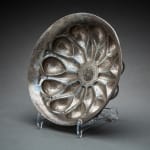Elamite Silver Vessel, 900 BCE - 800 CE
Silver
height 23.8 cm
height 9 3/8 in
height 9 3/8 in
PF.5728
Further images
Elam was an ancient kingdom of Asia, situated north of the Persian Gulf and east of the Tigris River, and corresponding approximately to the present-day province of Khuzistan in Iran....
Elam was an ancient kingdom of Asia, situated north of the Persian Gulf and east of the Tigris River, and corresponding approximately to the present-day province of Khuzistan in Iran. The capital of Elam and its most fabled city was Sûsa, today the city of Shûsh. This powerful empire has been overshadowed in history by the rival kingdoms of Babylon and Assyria. However, their extraordinary metalwork survives to this day, a testament to the expertise of their craftsman.
This shallow silver vessel demonstrates the absolute mastery of the Elamite artisans. The center of the bowl is incised with two concentric circles. From here, radiate eleven gadroons interspersed with plant shoots, all delicately hammered out of the silver. On the exterior, the plant shoots have been embellished with incised details of leaves and stalks. Above this motif, below the flaring lip, is a series of four finely engraved lines repeated three times. Perhaps the most fascinating, and important, feature of this beautiful vessel is a inscribe dedication in Neo-Elamite cuneiform script. Found on the inside of the lip, the text can be translated as, “Unsak, king of Samati, son of Zi’uttiyash.” This vessel, once the prized possession of a king, is even more valuable today because of the obscurity of the inscription. These two kings are only known through silver vessels such as this; even the precise location of ancient Samati remains a mystery. While King Unsak once ruled over a vast empire, no doubt amassing countless treasures, today his memory is preserved through the remnants of his wealth. This vessel is not just a gorgeous work of art, but also the only lasting tribute to a life, a ruler, and an empire.
This shallow silver vessel demonstrates the absolute mastery of the Elamite artisans. The center of the bowl is incised with two concentric circles. From here, radiate eleven gadroons interspersed with plant shoots, all delicately hammered out of the silver. On the exterior, the plant shoots have been embellished with incised details of leaves and stalks. Above this motif, below the flaring lip, is a series of four finely engraved lines repeated three times. Perhaps the most fascinating, and important, feature of this beautiful vessel is a inscribe dedication in Neo-Elamite cuneiform script. Found on the inside of the lip, the text can be translated as, “Unsak, king of Samati, son of Zi’uttiyash.” This vessel, once the prized possession of a king, is even more valuable today because of the obscurity of the inscription. These two kings are only known through silver vessels such as this; even the precise location of ancient Samati remains a mystery. While King Unsak once ruled over a vast empire, no doubt amassing countless treasures, today his memory is preserved through the remnants of his wealth. This vessel is not just a gorgeous work of art, but also the only lasting tribute to a life, a ruler, and an empire.





